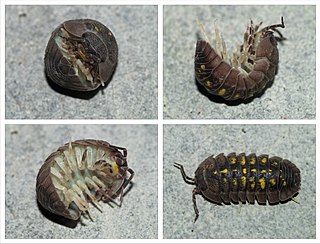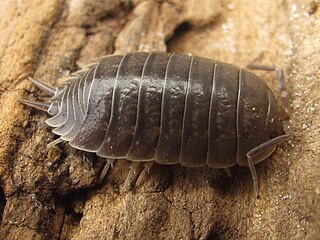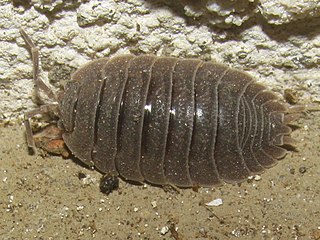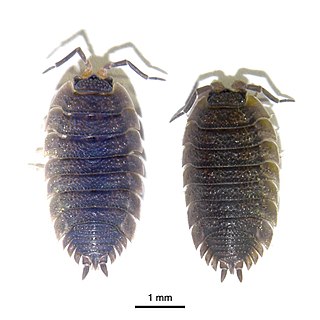
Armadillidiidae is a family of woodlice, a terrestrial crustacean group in the order Isopoda. Unlike members of some other woodlice families, members of this family can roll into a ball, an ability they share with the outwardly similar but unrelated pill millipedes and other animals. This ability gives woodlice in this family their common names of pill bugs or roly polies. Other common names include slaters,potato bugs, butchy boys and doodle bugs. Most species are native to the Mediterranean Basin, while a few species have wider European distributions. The best-known species, Armadillidium vulgare, was introduced to New England in the early 19th century and has become widespread throughout North America.

Armadillidium vulgare, the common pill-bug, potato bug, common pill woodlouse, roly-poly, slater, doodle bug, or carpenter, is a widespread European species of woodlouse. It is the most extensively investigated terrestrial isopod species.

Sphaeromatidae is a family of isopods, often encountered on rocky shores and in shelf waters in temperate zones. The family includes almost 100 genera and 619 known marine species. Within these genera, there are groups that share distinctive morphologies; further research may reclassify these genus-groups as separate families.
Haplophthalmus abbreviatus is a species of woodlouse in the family Trichoniscidae. It is found in Europe & Northern Asia.

Haplophthalmus is a genus of woodlice in family Trichoniscidae. It contains 47 described species, of which two are listed as vulnerable species on the IUCN Red List – Haplophthalmus abbreviatus and Haplophthalmus rhinoceros.

Porcellio laevis is a species of woodlouse in the genus Porcellio. As the species epithet laevis as well as the vernacular name "swift woodlouse" suggests, the species is capable of quick bursts of speed when provoked.

Trichoniscidae are a family of isopods (woodlice), including the most abundant British woodlouse, Trichoniscus pusillus. Most species of woodlice that have returned to an aquatic or amphibian way of life belong to this family. Several species from the following genera live in water and on land: Titanethes, Cyphonetes, Alpioniscus, Scotoniscus, Bureschia, Brackenridgia, Mexiconiscus, Trichoniscoides, Cretoniscellus, Balearonethes and Cyphoniscellus.

Ariophantidae is a taxonomic family of air-breathing land snails and semi-slugs, terrestrial pulmonate gastropod mollusks in the superfamily Helicarionoidea.

Philoscia muscorum, the common striped woodlouse or fast woodlouse, is a common European woodlouse. It is widespread in Europe, the British Isles and is found from southern Scandinavia to the Ukraine and Greece. It has also spread to Washington and many states in New England, also the mid-Atlantic states of Pennsylvania and New Jersey, as well as Nova Scotia.

Trichoniscus pusillus, sometimes called the common pygmy woodlouse, is one of the five most common species of woodlice in the British Isles. It is acknowledged to be the most abundant terrestrial isopod in Britain. It is found commonly across Europe north of the Alps, and has been introduced to Madeira, the Azores and North America.

Androniscus dentiger, the rosy woodlouse or pink woodlouse is a species of woodlouse found from the British Isles to North Africa.

Ligidium is a genus of woodlice. It contains about 46 species, six of which are probably taxonomic synonyms of Ligidium hypnorum or Ligidium germanicum. Of the remainder, eight species are found in North America, six in Japan, two in Taiwan, four in China, 12 in Turkey, the Caucasus, and Central Asia, and six in Greece.

Julida is an order of millipedes. Members are mostly small and cylindrical, typically ranging from 10–120 millimetres (0.39–4.72 in) in length. Eyes may be present or absent, and in mature males of many species, the first pair of legs is modified into hook-like structures. Additionally, both pairs of legs on the 7th body segment of males are modified into gonopods.

Porcellio dilatatus is a species of woodlouse in the genus Porcellio belonging to the family Porcellionidae. This species is widespread in Europe, and has also been introduced to North America from Western Europe. They are 15 millimetres (0.59 in) long, are brown coloured and striped. They can be found feeding on alder leaves, but mostly feeds on organic food substrates, such as lettuce in the wild. It also feeds on inorganic metal salts.

Armadillidae is a family of woodlice, comprising around 80 genera and 700 species. It is the largest family of Oniscidea, and one of the most species-rich families of the entire Isopoda. Armadillids generally have a strongly convex body shape, with some rather shallowly convex. Like members of the woodlice family Armadillidiidae, armadillids are capable of enrolling into a sphere (conglobation), and are commonly known as pill bugs. Armadillids differ from the Armadillidiidae in that the antennae are fully enclosed within the sphere.

Armadillidium nasatum, the nosy pill woodlouse, is a large, Western European-based species of woodlouse that has been introduced to North America, along with Armadillidium vulgare also found in other parts of Europe.
Alloniscus is the sole genus in the woodlice family Alloniscidae. There are more than 20 described species in Alloniscus.

Cylisticidae is a family of woodlice in the order Isopoda. There are at least 4 genera and more than 60 described species in Cylisticidae.

Invertebrate iridescent virus 31 (IIV-31), also known informally as isopod iridovirus, is a species of invertebrate iridescent virus in the genus Iridovirus. Oniscidea serve as hosts. Infection is associated with decreased responsiveness in the host, increased mortality, and most strikingly, the emergence of an iridescent blue or bluish-purple colour due to the reflection of light off a paracrystalline arrangement of virions within the tissues.

















